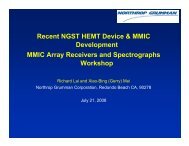Final Report - Keck Institute for Space Studies - Caltech
Final Report - Keck Institute for Space Studies - Caltech
Final Report - Keck Institute for Space Studies - Caltech
- No tags were found...
You also want an ePaper? Increase the reach of your titles
YUMPU automatically turns print PDFs into web optimized ePapers that Google loves.
Figure 4.4: Comparison of experimental, theoretical, and numerical results <strong>for</strong> the time of arrival time on theinstrumented particle (TOF) and amplitude ratio of the primary and secondary reflected solitary waves in the chainof spheres, as a function of the upper layer thickness (Lu) in the composite media. (a) TOF <strong>for</strong> the PSWs. Thearrival time is within 0.43- to 0.47-ms range. (b) Amplitude ratio <strong>for</strong> the PSWs. The amplitude reflection ratioincreases as Lu grows. (c) Time of flight <strong>for</strong> the SSWs. Compared to that of the PSWs, the progression is in oppositedirection with improved responsiveness. (d) Amplitude ratio of the SSWs. On the contrary to the PSW reflectionin (b), larger Lu yields the smaller SSW reflection in compensation <strong>for</strong> the increased PSW reflection. For the upperlayer taller than 22 mm, the magnitude of the reflection ratio drops below 104.2 Interaction of highly nonlinear waves with a composite mediumWe consider the interaction of solitary waves with an adjacent composite-layered system. Thenonlinear actuator system can be used in engineering applications <strong>for</strong> NDE/SHM of layers hiddenunderneath the surface of a composite system. The goal of this study is to understand how thenature of wave interaction and properties of reflected waves are affected by the material propertiesand geometry of the layered medium. Fig 4.1b shows the finite element modeled <strong>for</strong> a two layercomposite medium. A stiff (stainless steel cylinder) medium is placed at the top and soft (polytetrafluoroethylene,PTFE cylinders) at the bottom. We analysis the effect of upper layer inertia onthe reflected pulses by varying the height of top cylinder. We also study the influence of the lowerlayer cylinder on the nature of reflected waves, by varying the thickness of the bottom cylinder.For the composite medium, the SSWs are <strong>for</strong>med because of elastic resistance of the lower medium.The initial collision of the last particle in the chain causes the translational motion in the upperlayer towards the soft lower layer (PTFE layer), thereby compressing it. After the contact time,the lower medium rebound back, which results in bouncing of upper layer towards the chain. Theupper medium collides with the granular chain, which triggers the <strong>for</strong>mation of the SSWs.4.2.1 Effects of variable thickness of the upper layer of composite mediumBy varying the height of upper layer media while keeping the dimension of the PTFE base constant,we evaluate the effect of the layer mass on the solitary wave interaction. Fig 4.4a shows the intensityof wave amplitude in granular chain. The change in geometry of the upper layer affects the timeof propagation of both the PSWs and SSWs as the mass of the upper layer changes (Fig 4.4b andFig 4.4c respectively) . The results shows that the arrival time and reflection ratios of the primarysolitary waves are mainly governed by the mass of the upper medium. The inertia of upper mediaincreases most of incident energy is carried by the PSWs, which result in disappearance of thesecondary solitary waves.4.2.2 Effects of variable thickness of the lower layer of composite mediumTo understand the effects of secondary layers in composite medium on the reflected signals fromnonlinear actuator, we per<strong>for</strong>med study on composite medium. In this study, the upper layer massand geometry was held constant, while varying the height of lower layer. As shown above, PSWs aregenerated by the initial impact of last bead with upper layer and since the upper layer is maintainedsame the AR and TOF of PSWs are constant <strong>for</strong> wide range of lower (PTFE) layer. The studyshows that, even though the AR of SSWs is less sensitive to the height change of lower layer, theTOF of SSWs varies significantly as the thickness of the lower layer changes. The <strong>for</strong>mation of12















